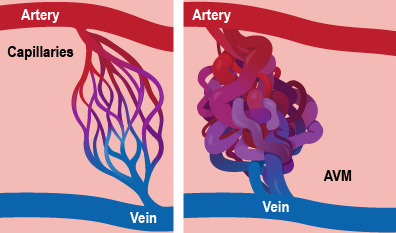The Simple Answer
AVM stands for Arteriovenous Malformation...
Think of it like a highway...

Normal blood vessels (left) show capillaries between arteries and veins. In an AVM (right), those capillaries are missing, causing tangled connections.
How Blood Vessels Normally Work
Your body has three types of blood vessels that work together like a team:
Arteries - These carry oxygen-rich blood away from your heart. The blood moves fast and has high pressure, like water from a fire hose.
Capillaries - These are tiny vessels that act like a bridge. They slow down the blood so it can deliver oxygen and nutrients to your body's tissues. This is super important!
Veins - These have thinner walls and carry blood back to your heart. The blood is now slower and has low pressure.
The normal path: Heart → Arteries (fast blood) → Capillaries (blood slows down and delivers oxygen) → Veins (slow blood) → Heart
What Happens with an AVM
In an AVM, the capillaries are missing. The high-pressure blood from the arteries flows directly and rapidly into the weaker veins.
Remember, veins have thin walls and are only built to handle slow-moving blood. When fast, high-pressure blood rushes into them, it causes big problems.
Why AVMs Are Dangerous
Not enough oxygen: Because the blood rushes through so fast, it doesn't have time to deliver oxygen to the surrounding tissue. This can cause the cells to weaken or even die.
Risk of rupture and bleeding: The rapid, high-pressure blood flow can cause the fragile veins to stretch and weaken. If they rupture and bleed, it becomes a life-threatening medical emergency. In the brain, this can cause a stroke or brain damage.
Pressure on tissue: Large AVMs can grow and push on surrounding parts of the brain, spinal cord, or other body parts, disrupting how they normally work.
Where Do AVMs Happen?
AVMs are most common in the brain and spinal cord, but they can occur anywhere in the body.
Brain AVMs - These are the most common and most dangerous. About half of all AVMs are in the brain.
Spinal cord AVMs - Can cause back pain or problems with movement.
Face and body AVMs - Like Isabelle has. These can cause visible swelling and bumps where blood collects.
Symptoms - How Do You Know If Someone Has an AVM?
Many people have no symptoms: Some people don't know they have an AVM until a doctor finds it during a scan for something else.
When symptoms do occur, they can include:
• Headaches
• Seizures
• Muscle weakness
• Vision problems
• Difficulty speaking
• Visible swelling or bulging (for AVMs on the face or body)
Important: Sometimes the first sign of a brain AVM is a hemorrhage (bleeding in the brain). This is a medical emergency.
Quick Facts About AVM
✓ Most people are born with AVMs - they don't develop later in life
✓ AVMs are usually NOT inherited from parents
✓ The exact cause is unknown
✓ About 1 in 100,000 people have an AVM
✓ AVMs often get bigger as a person grows
How Are AVMs Treated?
Doctors have several ways to treat AVMs to reduce the risk of bleeding:
Surgery: The doctor removes the AVM through an operation.
Embolization: The doctor blocks the blood vessels feeding the AVM using a special glue-like substance. This stops blood from flowing through the tangle.
Focused radiation: Special radiation beams are aimed at the AVM to make it shrink and close over time.
Sometimes doctors use more than one of these treatments together to get the best results.
Isabelle's AVM Story
Isabelle was born with an AVM on her face. When she was a baby, you could see some blood vessels, but it wasn't very big.
As Isabelle grew up, the AVM grew too. It got bigger and more swollen. The high-pressure blood flowing into the weak veins caused them to stretch and bulge, creating a visible bump on her face.
She had her first surgery in December 2017 when she was 16 years old. The surgery helped, but she needs more surgeries to completely fix the problem. Because she lost her insurance when she turned 18, she hasn't been able to get the additional surgeries she needs.
That's why we're asking for help. Isabelle deserves to get the medical care she needs to live a healthy, normal life.
Why AVM Awareness Matters
Most people have never heard of arteriovenous malformations. When people don't understand a medical condition, it's harder for those who have it to get support and understanding.
October is AVM Awareness Month - a time to help people learn about AVMs and understand what people like Isabelle are going through.
By sharing this information and Isabelle's story, you're helping to:
• Educate others about what AVMs are
• Help people understand why treatment is so important
• Support research for better treatments
• Give hope to others living with AVMs
Thank you for taking the time to learn about AVMs. Your support means everything to Isabelle and others living with this condition.
💗 In honor of AVM Awareness Month, please share Isabelle's story and help others understand this rare condition. Every share spreads hope. Every prayer matters.